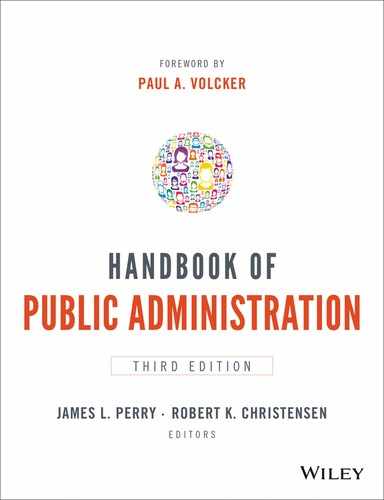Part 4
Managing for Public Performance
The chapters in part 4 put the spotlight on the bottom line: public performance. Performance measurement and program evaluation have become powerful tools for promoting effectiveness. Achieving high performance is about more than measurement and evaluation, however. High performance also depends on thinking and managing strategically, using public service to direct and inspire staff, and attracting and engaging a diverse workforce. In light of growing complexity and the rapidity of change, high performance also rests with managing collaborations and organizational change processes.
Regardless of how one identifies public administration, contemporary constituents agree on one thing: public administration should be high performing. From the federal revenue agent to the motor vehicle license examiner, local, state, and national conversations focus overwhelmingly on results.
Performance is neither self-instituting nor self-sustaining, and Richard Walker, Chan Su Jung, and Gong-Rok Kim focus in chapter 15 on the role of strategic management in fostering performance. Strategic management has become an important tool in the repertoire of public administrators seeking to build high-performing organizations, and strategic management offers a means for systematically thinking about and reviewing an organization's or community's direction, environment, and strategies. These authors wisely remind us that strategic management is not a single tool, but a set of considerations designed to maximize performance in dynamic environments. Public administrators who are adept at applying the right strategic management tools in the right situations can realize significant payoffs for their organization.
Contemporary public administration is more reliant than ever before on collaborative arrangements for action, and in chapter 16, Michael McGuire and Chris Silvia identify five categories of activities that can help administrators become effective collaborative managers.
The idea of performance monitoring and measurement is developed more generally by Harry Hatry in chapter 17. Performance measurement has been used for many years in government and is becoming increasingly prominent, given the influences of fiscal stringency, information technology, social media, and demands for results. Public administrators wisely employ multiple performance indicators that give insight into output, outcome, and efficiency. Effective performance measurement is a beacon for change and is critical to improvement in the public sphere.
Program evaluation seeks to assess the effects of programs holistically. Kathryn Newcomer provides insights in chapter 18 about strategies for enhancing the objectivity and utility of program evaluation. Like other aspects of the policy process, struggles over values permeate policy and program evaluation. The success or failure of a policy can turn on which criteria are selected for judging its contributions, what groups are sought out for their views, and when the evaluation is conducted.
Evaluation-driven performance improvements ultimately depend on leadership and management of human capital—a theme carefully considered by Wouter Vandenabeele and Nina Mari Van Loon in chapter 19 as they focus on public service motivation. They argue that if our understanding of public service motivation as a tool to increase performance is embedded in a broader human resource management strategy, it can be harnessed to improve many outcomes in and from public organizations.
David Pitts and Sarah Towne develop another important aspect of human capital's relationship with public performance. In chapter 20, relating back to the role of strategic management in improving public performance, they illuminate an argument that if diversity management is part of an organization's strategic process, it can improve organizational performance overall.
The theme of organizational change and its tight connection with performance is treated more broadly by Sergio Fernandez in chapter 21. Any meaningful discussion of improving organizational performance frequently includes a hard look at organizational change. Whether through diversity management, motivation-focused human resource management, program evaluation, systematic performance measurement, or strategic management, organizational change plays a role in each contributor's vision of performance in part 4. Fernandez is highly attentive to the process side of change and zeroes in on the resistance that too often impedes improved performance. His suggestions to reduce resistance can be applied to changes proposed throughout this book to ensure that organizational change yields the intended performance benefits.
